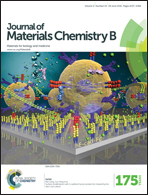Surface zwitterionization of customized 3D Ti6Al4V scaffolds: a promising alternative to eradicate bone infection†
Abstract
Large and critical bone defect reconstruction is still a hard challenge in tumor resections, non-unions, some traumatisms and articular prosthesis revisions. The application of electron beam melting technology (EBM) to implant manufacturing constitutes a promising alternative, which provides better biomechanics and customized solutions. Implant infections are one of the most serious complications associated with surgical treatments, which require immediate solutions for achieving better clinical results. Herein, to confer antimicrobial properties, a simple and cost-effective approach based on a bifunctionalization process to create a zwitterionic surface on Ti6Al4V EBM implants is proposed. The obtained results show a notable reduction of bacterial adhesion (more than 97%) and total inhibition of biofilm formation, combined with demonstrated biocompatibility and bioactivity, permitting cell adhesion on the entire surface of these 3D zwitterionic scaffolds. This surface zwitterionization provides new perspectives for custom-made Ti6Al4V EBM implants for bone tissue regeneration with antimicrobial properties.


 Please wait while we load your content...
Please wait while we load your content...